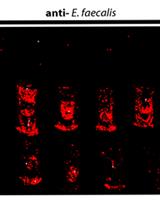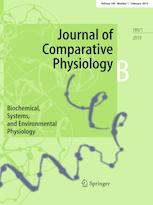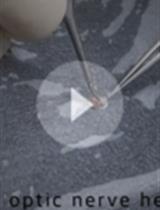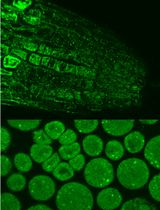- EN - English
- CN - 中文
Quantification of Cutaneous Ionocytes in Small Aquatic Organisms
小型水生生物皮肤离子细胞的定量分析
发布: 2019年05月05日第9卷第9期 DOI: 10.21769/BioProtoc.3227 浏览次数: 5311
评审: Gal HaimovichMichelle GoodyYong Teng

相关实验方案

在纤维蛋白原包覆的硅胶导管和96孔聚苯乙烯板上进行生物膜检测
Cristina Colomer-Winter [...] Ana L. Flores-Mireles
2019年03月20日 6831 阅读
Abstract
Aquatic organisms have specialized cells called ionocytes that regulate the ionic composition, osmolarity, and acid/base status of internal fluids. In small aquatic organisms such as fishes in their early life stages, ionocytes are typically found on the cutaneous surface and their abundance can change to help cope with various metabolic and environmental factors. Ionocytes profusely express ATPase enzymes, most notably Na+/K+ ATPase, which can be identified by immunohistochemistry. However, quantification of cutaneous ionocytes is not trivial due to the limited camera’s focal plane and the microscope’s field-of-view. This protocol describes a technique to consistently and reliably identify, image, and measure the relative surface area covered by cutaneous ionocytes through software-mediated focus-stacking and photo-stitching–thereby allowing the quantification of cutaneous ionocyte area as a proxy for ion transporting capacity across the skin. Because ionocytes are essential for regulating ionic composition, osmolarity, and acid/base status of internal fluids, this technique is useful for studying physiological mechanisms used by fish larvae and other small aquatic organisms during development and in response to environmental stress.
Keywords: Chloride cell (氯离子细胞)Background
Ionocytes (formerly called chloride cells and mitochondrion-rich cells) are specialized cells that transport ions to regulate the ionic composition, osmolarity, and acid/base status of internal fluids (reviewed in Evans et al., 2005). Ionocytes typically express high levels of the enzyme Na+/K+ ATPase, which can be used to visualize them using immunohistochemical techniques. In larval and juvenile fishes, ionocytes are present throughout the skin (reviewed in Varsamos et al., 2005). The abundance, distribution, and size of ionocytes can change during development, as well as in response to environmental stressors such as temperature, acidification, salinity, hypoxia, UV light, and pollutants. However, accurate and consistent quantification of cutaneous ionocytes can be difficult due to their presence in large numbers (tens of thousands), non-homogenous distribution, and being masked by pigmented cells. In addition, ionocyte quantification throughout the entire skin of an organism is often limited by the microscope’s field-of-view (Fridman et al., 2011) and both the camera’s field-of-view and focal plane (Hiroi et al., 1999; Varsamos et al., 2002). Because ionocyte distribution is often quite variable across the larval skin, estimations of ionocyte abundance based on a single photograph and focal plane may not be representative of the organism as a whole, and therefore not reliable or repeatable. As such, previous studies that utilized immunohistochemistry to identify and quantify ionocytes have been descriptive in nature (Hwang, 1989; Hiroi et al., 1998; Katoh et al., 2000), which precludes replication and comparison across species and treatments.
Here, we describe a protocol involving immunohistochemistry, photo-microscopy, and photo-editing software that allows estimating ionocyte number, size, density, and relative coverage of cutaneous ionocytes with high accuracy. Unlike previous studies, our method resolves both frame-of-view and focal plane limitations through focus-stacking and photo-stitching software, effectively digitizing a 3-D fish larva into a 2-D image. Additionally, the resulting digital image retains its high-resolution–thereby allowing the accurate quantification of all ionocytes on one side of the larva along with their average size and the larva’s surface area. These parameters can then be inputted into a simple equation to estimate the cutaneous ionocyte ion-transporting capacity in relation to the total skin surface area of the specimen. For larger specimens in which counting all cutaneous ionocytes is cumbersome and time-consuming, we developed a random sampling protocol that allows highly accurate cutaneous ionocyte estimations after counting ionocytes within 10% of the skin surface area. For example, the estimated number of cutaneous ionocytes in a 13.7 mm long Yellowfin Tuna (Thunnus albacares) specimen was 15,342, which was only 3.6% higher than the actual 14,795 cutaneous ionocytes counted in the entire fish skin (Kwan et al., 2019). We believe this method will be valuable for future studies quantifying cutaneous ionocytes in larval and juvenile fish as well as other small aquatic organisms during development and in response to various environmental stress (e.g., ocean warming, hypoxia, and acidification).
Materials and Reagents
- PCR Reaction Strips (8 x 0.2 ml) attached flat cap (Simport, catalog number: T320-2N)
- 1.7 ml microcentrifuge tubes (Corning, catalog number: MCT-175-C)
- 15 ml plastic tubes (Corning Brand, catalog number: 352196)
- Microscope slides (Thermo Fisher Scientific, catalog number: 12-550-15) or concave microscope slides (United Scientific Supplies, catalog number: CS3X11)
- Microscope coverslips (e.g., VWR, catalog number: 48366 045)
- Microscope small Petri dish trays (MatTek Corp, catalog number: P35GC-1.5-10-C)
- Petri dish (Corning Brand, catalog number: 351029) or any other container
- Specimen of interest
Note: This protocol is optimized for small (< 30 mm) samples with relatively low natural pigmentation and. high transparency. This protocol could be used for other specimens, but additional optimization of immunostaining and image acquisition might be required. - Deionized (DI) water
- 10x Phosphate buffer saline (PBS) (Corning Incorporated, catalog number: 46-013-CM)
- 20% paraformaldehyde (PFA) (Electron Microscopy Sciences, catalog number: 15713)
- 200-proof (100%) Ethyl alcohol (Decon Laboratories, catalog number: 2701)
- 30% (w/v) hydrogen peroxide (Sigma-Aldrich, catalog number: H3410)
- α5 Na+/K+ ATPase (NKA) antibody (Developmental Studies Hybridoma Bank, catalog number: a5–supernatant)
Notes:- This monoclonal antibody has specifically recognized NKA from multiple classes of aquatic organisms including: bony fishes (Wilson et al., 2000 and 2002; Yang et al., 2013; Tang et al., 2014; Kwan et al., 2019), elasmobranch fishes (Piermarini and Evans, 2001; Roa et al., 2014; Roa and Tresguerres, 2017), and hagfish (Clifford et al., 2015).
- This protocol may be adapted for other proteins following validation of primary antibodies in the species of interest. However, successful localization using different primary antibodies may require optimizing the fixation and immunohistochemical procedures described here.
- Vectastain® Elite® ABC HRP ready-to-use kit (Vector Laboratories, catalog number: PK-7200), includes:
- Normal horse serum blocking solution
- Pan-specific secondary antibody solution
- Streptavidin peroxidase solution
- 3,3-diaminobenzidine (DAB) Peroxidase Substrate stored at 4 °C (Vector Laboratories, catalog number: SK-4100)
- Sodium azide (Thermo Fisher Scientific, catalog number: S227I-25)
- 1.2x phosphate buffer saline (PBS) solution (see Recipes)
- 4% paraformaldehyde (PFA) fixative solution (see Recipes)
- 3% hydrogen peroxide solution (see Recipes)
- 1.0x PBS solution (see Recipes)
- DAB substrate working solution (see Recipes)
- 10% sodium azide stock solution (see Recipes)
- 0.02% sodium azide working solution (see Recipes)
Equipment
- Fridge (4 °C) and freezer (-80 °C)
- Chemical fume hood
- Borosilicate glass vial (Thermo Fisher Scientific, catalog number: 033374)
- Shake table (e.g., VWR, Standard Orbital Shaker, Model 1000) or rotator (e.g., Thermo Fisher Scientific, Tube Revolver/Rotator, catalog number: 88881001)
- Transfer pipette (Thermo Fisher Scientific, catalog number: 1368050) or any other pipette suitable for your specimen of interest
- Fine forceps (Fine Science Tools, catalog number: 26029-10) or any forceps that does not damage your specimen of interest
- Camera-mounted microscope(s) Leica DMR compound microscope for smaller samples (< 5 mm SL), Leica MZ9.5 stereomicroscope for larger samples (> 5 mm)
- Microscope light source (Ludl Electronic Products [LEP] [12 V, 100 W], catalog number: 99019)
- Microscope mounted camera (Canon, Rebel T3i single lens reflex camera)
- Compatible camera with SD card
- Anti-vibration table for microscopy imaging
- Microscope stage micrometer standard
- Monitor for microscope camera’s live-feed imaging
- Camera remote for wireless shutter release (Canon RC-6)
Software
- Helicon Focus (HeliconSoft, Version 6.7.2 or later, www.heliconsoft.com)
- Adobe Photoshop (Adobe Systems, version CS3 or higher, www.adobe.com)
- Fiji (https://imagej.net/Fiji), or ImageJ (https://imagej.nih.gov/ij/download.html) with cell counter plugin (https://imagej.nih.gov/ij/plugins/cell-counter.html)
- Adobe Illustrator (Adobe Systems, Version 19.2.0 or later, www.adobe.com)
- R (https://www.r-project.org)
Procedure
文章信息
版权信息
© 2019 The Authors; exclusive licensee Bio-protocol LLC.
如何引用
Kwan, G. T., Finnerty, S. H., Wegner, N. C. and Tresguerres, M. (2019). Quantification of Cutaneous Ionocytes in Small Aquatic Organisms. Bio-protocol 9(9): e3227. DOI: 10.21769/BioProtoc.3227.
分类
细胞生物学 > 细胞成像 > 固定组织成像
生物化学 > 蛋白质 > 免疫检测 > 免疫染色法
您对这篇实验方法有问题吗?
在此处发布您的问题,我们将邀请本文作者来回答。同时,我们会将您的问题发布到Bio-protocol Exchange,以便寻求社区成员的帮助。
提问指南
+ 问题描述
写下详细的问题描述,包括所有有助于他人回答您问题的信息(例如实验过程、条件和相关图像等)。
Share
Bluesky
X
Copy link











